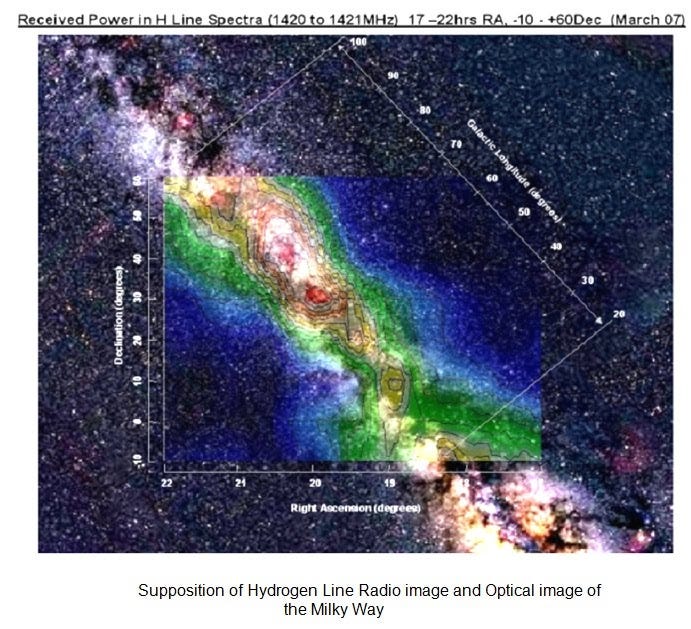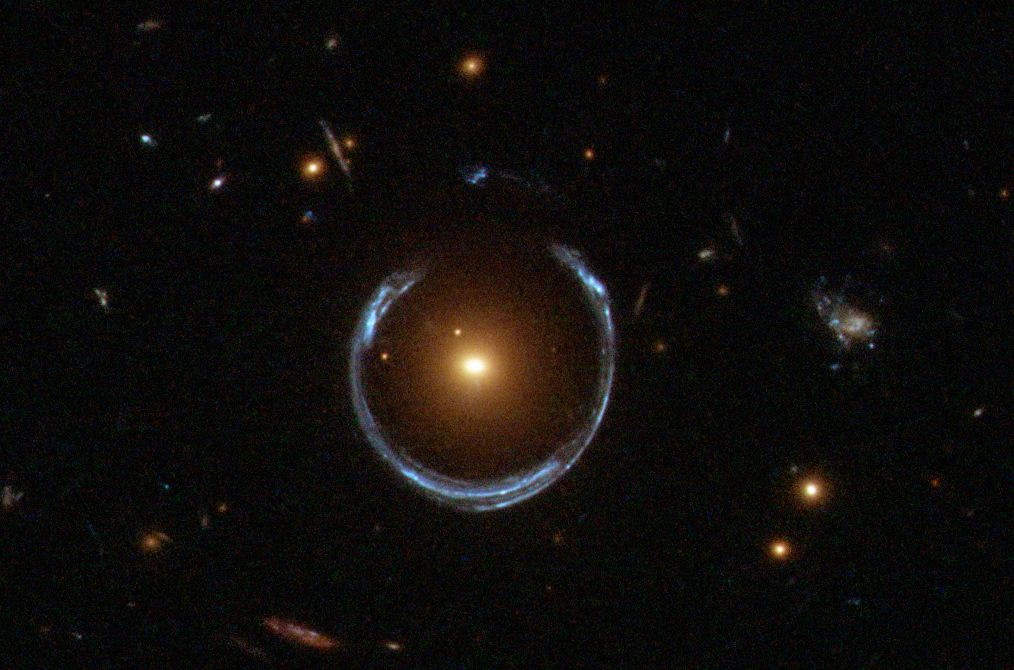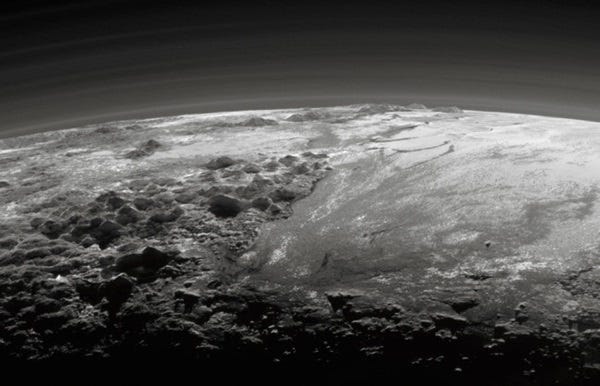Alone
The Final Blackpill on E.T.
I recently read the Remembrance of Earth’s Past, a Chinese sci fi trilogy with quite some criticism of Western thinking. It’s fair in criticizing the shortfalls of Eastern thinking too, but absolutely critical of Western identitarianism especially. Most curiously, the texts do this through a cheap form of time travel: Hibernation. Much of the book revolves around “hibernation” technology, allowing a collection of ideologues from the 21st century to coordinate human advancements over the course of some 400 years - although, every time they wake up they need to cope with the new and unexpected divergences humanity’s political currents have undergone. Also, as hibernation technology advances every time they wake up, that 400 year plan becomes 600, and eventually 18 million years, with some even considering hibernating until the end of the universe to see if it dissolves into infinity, or begins to crunch back into a singularity. Some desire to awake in a young new universe to ensure their values are enforced from day one. A basis of the books is “things can only get better”, but the books also shows how this is a faulty assumption: Earth experiences a mini apocalypse in between the first 400 year jump, which had they awoken to, they would have seen nothing but ruin.
Every time they wake up, these characters deal with both expected and unexpected changes in society: ridiculous fashion trends, feminization of culture, morality, etc etc. A woman notes that in some eras, she just can’t find men attractive because of how feminized they had become. In other eras, she notes “This was an era that could produce men once again”.
Remembrance of Earth’s Past is perhaps most famous for the scary concept of “Cosmic Sociology” (CS), or the study of how aliens may think and behave at cosmological scales. CS operates on two rules: "First, survival is the first need of civilization; second, civilization continues to grow and expand, but the total amount of matter in the universe remains the same." With this, the crux of CS theory is that communication cannot go faster than light, and at a cosmological scale this means it is nearly impossible to conduct serious diplomacy between species (The book violates this rule too, but all the same it’s important). The time it takes to communicate with other species is such that by the time a reply is received, it may be an entirely different civilization that answers it. Imagine if a Roman asked an alien what food they liked, and by the time they got an answer, a medieval German would be the recipient. You could send a message out as a cave man, and by the time you get an answer you could be landing on the moon. How do you conduct inter-generational communications with an alien, let alone your own people? At these scales, communication could very well be a net negative - indicating to the recipient “I am primitive, but future competition.” Anyone listening for hello beacons could get suspicious... Imagine if one species says hello, and then by the time another species can say hello back, that first species may have advanced to god-like technological levels. Why wait around for future competition? Here, CS theory comes to a rather dark conclusion: Rather than say hello, it may be better to send a bomb and eliminate potentially future threats. If you are a civilization and you have received replies, these worlds instantly become objects of competitions - only they are so far away, by the time you could learn anything about them for trade or discussion, they could be coming to invade you. Under these pressures, why would you ever respond? The time it takes to determine friend or enemy is simply too long. The safest path is silence.
CS calls this the “Chain of Suspicion”. Given enough time, and enough rotations of moralities, ethics, and civilizations between messages, eventually one of the two civilizations will be ruled by someone willing to bomb instead of talk. Given enough time, the civilization that fires first will likely win. More likely though, advanced civilizations will have dead-hand switches. If both fire between messages, both civilizations end. At a large enough time scale, the net civilizations left will be zero - unless they never send a message at all.
CS stipulates that natural selection at the cosmological scale favors quiet and fearful aliens over social and dynamic ones. The cosmos selects for paranoia. The oldest civilizations are the most paranoid. The most stable are the ones most secretive. It’s a very fun concept I can get behind. After all, the Earth doesn’t appear to be that unique compared to other worlds. Having a moon and large gas giant to shield you from asteroids helps, but it’s not the be-all and end-all. So, Earth should represent the normal course of development for any world of similar mass and distance from it's star.
But are they hiding? It’s true that no matter how many times we look at such worlds, we do not find any evidence for life. But does that mean there would be no way to observe anything at all?
Below I wish to present a number of angles and articulations I’ve collected over the years on how you could find life - even life that didn’t want to be found. You may ask how we could know this. Let’s explore:
Spectronomy
Correctly spelled, it’s spectroscopy. But I use this word for its astronomical uses. Some of you reading this may be familiar with the field of spectroscopy: the phenomenon that when light touches something, it exchanges information with what it touches. If you cast that ray through a prism, you will notice blank spots where the information is exchanged. Look closely:
This method allows some fairly accurate sampling of alien world’s atmospheres (if they have any), and in fact quite a few atmospheres have been sampled already. HD 189733b, a gas giant, has been found to have oxygen. But a gas giant having such gases is not at all unusual. HD 209458 b, another world with oxygen, is also a gas giant. But the oxygen there is thousands of degrees due to solar proximity.
A major life-sign is missing spectrums in the 450-475 nm and 650-675 nm ranges. These twin absorption indicates the presence of Chlorophyll, an undeniably living thing. To date, no world has shown this absorption line. But it would be a sure-fire way of detecting life. On Earth, Chlorophyll evolved at least four times, possibly more. Each time, creating a unique genetic imprint onto that lineage’s offspring. From this we can tell for certain Chlorophyll would be ideal spectrum lines to search for, given how often life prefers it. Centauri Dreams, a personal favorite blog from the early days of the internet, explores a 2016 paper that explores this spectroscopy via polarized light. A great read when you can:
Of course, the failure to detect any such spectrums is very sad, and for now is a dead end that one can hope has promise in the future - for now, it is a testimony most depressing: We are alone.
21 Centimeter Hydrogen Line
If you are clever, you likely know space may be mostly empty, but it is not truly empty. There’s stuff flying all over it. So you may be prone to think “how can we detect Chlorophyll if the light would keep hitting stuff?”. In comes the Hydrogen Line. This wave is too big to get absorbed by space gases and random junk. It is the universal emission of Hydrogen. A photon of 1420 mhz can pierce the veil and reveal physical objects from whence it came.
It would thus be the ideal frequency for radio communication at the cosmological scale. You can be fairly certain that the wave length will arrive at any destination. Of course, the problem is that while that wavelength will pierce the cosmic shroud, it will gradually lose amplitude every time it interacts with hydrogen. Eventually, the amplitude falls below the cosmic background noise, becoming indecipherable.
Many have used this fact to point out why SETI is a massive waste of money. But I would disagree. If someone were out there and really wanted to talk, they could shoot out a cosmic flare. A hydrogen line burst of sufficient amplitude to be seen many hundreds of light-years away. Returning to my favorite early internet blog, Centauri Dreams, Paul Gilster describes this as a “civilizational funeral pyre”.
One could imagine this as a simple device. It could be as small as the ISS, granted it would need a massive energy source. It would sent out a call-sign to the stars, at sufficient amplitude of the 1420 mhz Hydrogen Emission line to echo out into the stars “I am here”.
Of course, when we look out to the stars, there are no Funeral Pyres. The Hydrogen Emission line shows no cosmic flares by intelligent flare-gun holders. The closest we get is the famous 1977 WOW! signal, which was a one-off anomaly yet to be repeated.
The WOW! signal lasted 72 seconds - the maximum allowable listening time, so it likely lasted longer - but featured no modulation. Modulation is how information is usually transmitted in radio-waves, and thusly this signal was not a message, but indeed more like a flare indicating one’s existence. But before you get jumpy, it has been found that at the time of the signal, the comets 266P/Christensen and 335P/Gibbs were in the area of observation. These comets were only discovered in the 2000s, and were unknown at the time of the detection. Thus it is likely the burst of Hydrogen emission was simply the comets offgasing as they passed through the area of interest. Another dead-end indicating we are indeed alone…
Neutrinos
Some smarty pants will want to point out Neutrinos here: The little buggers that can fly through an entire planet because they are such small particles. This is a decent point. SN 1987A, for instance, is a source of cosmological neutrinos. It is 168,000 light-years away. So we can say with certainty that if you wanted to send a message in a cosmological bottle, this would be a very effective method with long distances.
But so far current neutrino detectors have found nothing special. I remain hopeful here for future investigations, but if anyone was nearby, we’d likely have heard them by now if they were using Neutrinos. This really would be an effective method to communicate, but still limited to light speed. None the less, for now, it is further proof we are alone…
SN 1987A, a source of neutrinos.
Cosmological Tourism
There another way we could attempt to detect aliens. If we assume they, like us, have inquirious minds and that is why they are out there in the first place, maybe it’s not the right method to try to find their homeworld? Imagine you are an alien, and you want to send a probe to the Earth. You have some vague idea of the Earth based off messages and pictures, but you are an outside observer who is too far away to know specifics. You are tasked with picking a spot on the Earth to send a probe and try to find humans. Chances are, picking randomly, you’ll end up in a desert or the ocean. No one would be nearby for you to even detect civilization. Let’s say you can make out the coastlines and some geological features. Well, now you may be able to get a better guess. Chances are, an intelligent species will want to take advantage of some of these geological features. Perhaps even to see it for the aesthetics.
We can apply this logic to the cosmos. Picking random stars to listen to seems as futile as picking a random spot on the Earth and landing in the ocean. We should try to aim for the tourist attractions. For instance, only 190 light-years from the Earth is HE 1523-0901, nicknamed Methuselah. It is the oldest known star in the galaxy. In fact, current data says it could be older than the universe itself! Unlikely to be true, of course. But at 13.7 to 14.5 Billion Years old, this star is likely older than the galaxy itself. It is a metal-poor star, and roughly twice the size of our own star. Given that the second closest oldest star is over 900 light-years away, this is an obvious tourist spot for any aliens in our neighborhood. The star’s anomalous age and characteristics would attract any species capable of FTL towards it for study. We are extraordinarily lucky to have a star this unique so close to us.
Of course, when Methuselah is observed, nothing stands out beyond its age and low quantity of metal. This star ought to be a natural wonder, attracting visits from any civilization close enough to see it. There are over 200,000 stars within a 500 light-year radius of Methuselah. Are we the only ones who would want to visit if we could? At least in this corner of the universe, it appears we are most certainly alone…
Distortion Waves
Most scientists agree now that a form of pseudo-FTL travel is possible, known as an Alcubierre drive. The principal would be to compress space-time in front of you in order to fall into a gravity well, and ideally also expand space-time behind you. This would create a gravitational wave large enough to “surf” on.
If a civilization existed that was building and using Alcubierre drives, this would be one of the easiest things to find. Because as the Alcubierre drive zooms across the cosmos, it would create gravitational rippled in passing light beams.
You can actually see such ripples in natural gravitational waves quite easily. Look how this orange galaxy distorts the image of a galaxy behind it:
Humans have been using the sun’s gravity to observe this lensing effect for over a century. Back in 1919, Sir Arthur Eddington built a device for measuring it in Brazil:
The detection of gravitational waves is rather new, but a proliferating field. You can imagine how strongly gravitational distortions for surfing on space-time would appear from Earth, as waves of a ship passing over water can send them out for miles. The waves required to surf would actually be quite massive, and thus an Alcubierre drive would be impractical to use within a solar system. These waves could shake a planet out of their orbit at close distances, but between stars the gravity wave amplitude would decay sufficiently to only make a wobble by the time they reached a solar system. At such minuscule scales, the influence practically nullifies itself.
But, if anyone was using these, we would find gravity wakes, especially around cosmological tourist attractions like Methuselah star. They would make gravitational wakes the size of planets and stars but be traveling at millions of kilometers a second. Dark matter would be a great candidate, were it not stationary. So, despite being practical and possible, we see here yet another piece of evidence that we are alone…
Life Rocks
The Earth has about 4,660 species of minerals. These are various kinds of rocks, crystals, patterns, etc. Did you know Earth has the most? Most planets in the solar system have 1,000 or fewer. The reason for this is because many of the mineral species on Earth are a direct consequence of water, and life’s influence. Stones that simply cannot develop without a biosphere’s influence. Now, as you may recall, everything light touches leaves a spectrum indicating what the light touched. So, if we know certain minerals are created by a biosphere, and we know their spectrum data lines, why not scan for those? Surely somewhere - even if it’s a dead world that blew up - there ought to be these minerals if life is out there.
Nope. Not a one has been found - at least from what I’ve read. Oxidation-zone materials would be what we would primarily be looking for. These would be minerals only possible in an oxygen-rich environment with similar temperature, hydration, and air pressure to the Earth. This includes minerals such as azurite, malachite, some forms of gold and silver, chalcocite, and chalcopyrite. If life were common in the universe - well, specifically life like Earth’s - then these minerals would be wide-reaching and easily detectable from many exoplanet spectronomies. Of course, as we mentioned before, we do find oxygen in some worlds. But they don’t produce these minerals, because they are 10,000 kelvin and literally plasma. This is, for me, one of the strongest nails in the coffin for aliens: There simply aren’t any mineral material evidences. Surely a planet the size of Earth, or bigger, which had ideal conditions would be like a glowing lighthouse ablaze with these spectrums, casting emissions into the void with an amplitude of light wave equal to that of the planet itself. But instead, we see only the basics: Methane, Carbon Dioxide, Hydrogen, etc etc. It appears nothing has managed to. Which, to be frank, is sad for another reason: We do see water is very common in the universe, and water can be an oxidizer. That it fails to do so suggests it is by and large in a solid form in space, interacting very little.
Thus on the matter of minerals, we see another piece of evidence that We are very alone…
Universal Habitability
When I first heard UH, I was blown away by how simple and elegant it is. UH theory is stupid simple, but sound. It states two simple axioms:
1: The universe started very hot.
2: The universe is now very cold.
Between these two axioms is all of entropy, and any attempt to delay it. It may not seem very important but consider the consequences: Every single part of this universe, at some point, experienced an era of Earth-like temperatures. A period of liquid water, fair winds, and comfortable conditions. Indeed, when we look out into the cosmos, that’s exactly what we see. The dead rivers of Mars, the tempting canyons of Venus, even the frozen seas of Pluto - it seems every planet had a point in its history where the surface was very dynamic, and as it cooled down that era came to an end.
The consequences of this should not be overlooked. It applies even to forms of life other than carbon-based oxygen and water dependent life like ours. All life is entropy management, and temperature is a big component of that. All life must operate across some range of ideal temperatures and pressures to persist. Ergo, every part of the universe has experienced the ideal conditions for life of any kind that could have potentially arisen upon it. This means every world should have some kind of life. Or, if not that, evidence of past life. But as we can see, there doesn’t appear to be. Some may bring up the Martian meteors with what look like fossils, or the offgasing of Venus which suggests life. These are haphazard at best. Were such worlds in viable conditions, life would have spread across their surface and been found on every rock.
UH is more than a nail on the coffin of ET. It’s throwing the coffin into a a furnace.
Earth is the Anomaly
Assuming aliens may be real, the lack of even minor spectralogical evidence hints that if they are real, most biospheres may not be as “naked” as the Earth’s. Consider this: Earth’s biosphere is in direct contact with solar radiation. And for most of life, that radiation kills. In fact, plants do get cancer from the sun quite often. But because they don’t have mobile cells like animals (White cells, red cells, etc), their cancers are never able to spread. That part of the tree simply dies. In fact, earlier in Earth’s history, trees were armored to protect themselves from the dangerous surface world. This may hint that Earth could be unique here, and that for most worlds the protection of the organism is more important.
Ancient Bark was curiously thick.
It may be that biospheres, on average, develop very good camouflages and armors early in their development. Earth’s fully exposed biosphere may simply be an anomaly.
Even so, it’s likely sea-born microbes would still show Chloraphyl spectrums. But this is an important factor to consider.
Conclusions
Consider this the final blackpill on E.T. This compilation of metrics is wide reaching, and I hope it displays the vast unlikelihood that aliens exist. If we haven’t even found chlorophyll spectrum lines, what hope is there really? The universe may have tiny microbial entropy machines scattered about, but there appears to be absolutely nothing in terms of complex life. That’s a dang shame to me. But that’s ultimately a fair conclusion.
If we were to speculate, there are a number of reasons this could be the case: Consider, for instance, had we developed early in Earth’s history we would never have had any petrochemicals with which to industrialize and build rockets with. We’d be an intelligence stuck here until we worked out an alternative. Any older aliens may have this problem, and simply be landlocked. It may just be the case that the universe needed until this time period to provide the chemicals to do industrial work, and any planet that developed an intelligence earlier simply did not get a fair hand and lost the game. Indeed, it’s possible natural selection could have favored against intelligence and they died out before they could do anything. For such a world, no intelligence would ever be detected. But then again, why haven’t we detected even simply biological spectrums?
Contrarily, imagine a planet with half the gravity we have. Such intelligence would find getting to space ridiculously easy, and yet we don’t see any of those either. So we can likewise conclude that intelligence may not develop in such easy situations. But we again have the problem: Where’s the spectrum lines?
To date, the furthest planet we have directly observed is 500 LY away. Similar to previous mentions, that places 200,000 solar systems - up to 2 million worlds at our observational mercy. Not one has displayed the parameters explored here. Of course, we’ve only actually looked at 30 of them. Even so, 30 worlds showing no sings in various ranges from 500 LY to 4 LY is as depressing as the alien who sends a probe to a random spot on Earth and finds only deserts and oceans. So, there’s hope. But call me a skeptic.
There’s a lot of reasons why I lean on aliens not existing - mostly spiritual and religious reasons. It’s not that I don’t think life ought to exist. Quite the contrary, the lack of evidence leans me to believe that life is hiding, and hiding implies existential threats. Maybe life is being harvested by forces unknown? But, the gap of knowing why is often the dwelling place of primordial monsters we cook up to fill in the blanks. Life could simply be unstable, and although plentiful, prone to extinguish itself quickly. Or, like I lean towards, aliens don’t exist at all.
One of my more wild conspiracy theories is that perhaps angels and demons used to be alien species in the past, but were harvested. Fun speculation, but worthless too. Ultimately, if a planet were harvested, we would still see the spectrums from before the harvest. But we don’t even see that.
There are no wakes from FTL ships. There are no spectrum lines from life-born minerals. There are no radio signals, flare guns, neutrino bursts, or anything at all that feature intelligence. We have sophisticated charts, graphs, models, and metrics for hundreds of natural phenomenon, but nothing from intelligence. We see a very active, but dead, cosmos. Arguing that life - something that has clearly left a mark on this planet and is as easy to find as picking up a rain drop - has left no trace whatsoever at the cosmological scale is just pure copium. I get you want space friends, but space has no friends.
For these reasons, I believe it is an absolute moral duty for us to preserve, cherish, and care for this wholly unique phenomenon we call life. We should spread it to the stars and make it a common occurrence. Because right now, it isn’t.















......aliens exist in DMT space......ie REM state or induced dmt release. Can they move into the materium, maybe not. Can infomation? Yes, absolutely. Space and time are not linear and it is marxist to assume so. The blue skinned aliens with cats eyes is what your hunting for. They are a hundred thousand years old and if they WISH to remain invisible in the materium they will remain so. Evidence of absence is not absence of evidence. There are plenty of dmt alien testimonies, take your pick. The ancients did.
Hi Bro